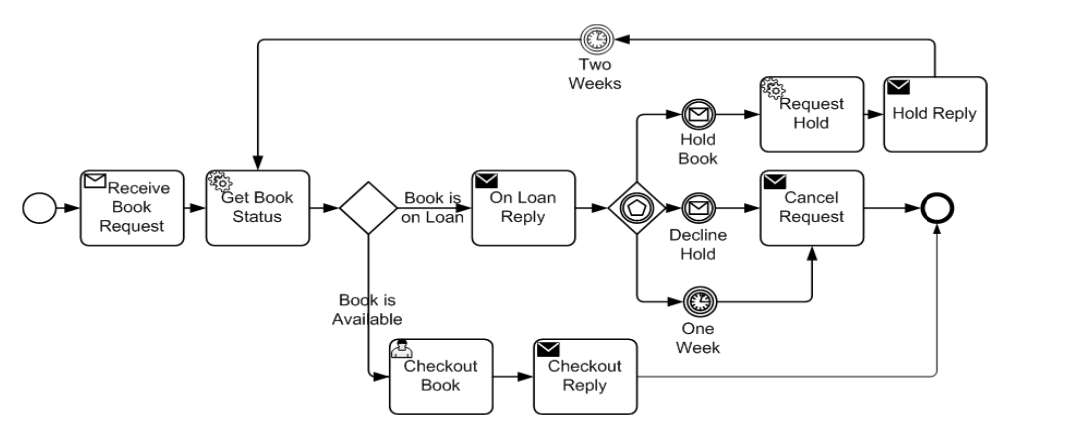Process 相关内容是 BPMN 流程建模标准和 BPMN 完整性标准所必须的. 但是,对于BPMN编排标准,BPMN执行标准,或 BPMN BPEL流程执行标准等不是必须的.
Process 描述了一个组织中的一系列以开展工作为目的的活动或流程. 在BPMN中,一个 Process 被描述为一个由流程元素构成的图,它们是一系列的 Activities, Events, Gateways, 和那些定义了有限执行语义的 Sequence Flows. Process 可以在任何级别定义,从企业范围的 Process 到由单个人员执行的 Process. 低级的 Process 可以组合在一起,以实现共同的业务目标.

注意,BPMN 术语 Process 专指一组流程元素. 它使用协作和编排对流程间交互建模.
Process 包包含用于流程建模的 Activities,Events 和 Gateways 等类, 以及它们如何在一个 Process 中排序的. 定义一个 Process 时,这些内容都包含在定义中.

一个 Process 是一个 CallableElement,使得其它 Process 可以通过 Call Activity 结构引用/重用它. 通过这种能力,一个 Process 可以引用一系列定义在外部的行为接口.
Process 是可重用元素,可以导入并在其他 Process 定义中使用
Process元素继承了CallableElement 和FlowElementContainer 的属性和模型关联
Process 属性 & 模型关联
| 属性名 | 描述/使用 |
|---|---|
| processType: ProcessType = none {None,Private,Public} | The processType attribute Provides additional information about the level of abstraction modeled by this Process. A public Process shows only those flow elements that are relevant to external consumers. Internal details are not modeled. These Processes are publicly visible and can be used within a Collaboration. Note that the public processType was named abstract in BPMN 1.2. A private Process is one that is internal to a specific organization. By default, the processType is “none,” meaning undefined. |
| isExecutable: boolean [0..1] | An optional Boolean value specifying whether the Process is execut- able.An executable Process is a private Process that has been modeled for the purpose of being executed according to the semantics of Chapter 14 (see page 426). Of course, during the development cycle of the Pro- cess, there will be stages where the Process does not have enough detail to be “executable.”.A non-executable Process is a private Process that has been modeled for the purpose of documenting Process behavior at a modeler-defined level of detail. Thus, information needed for execution, such as formal condition expressions are typically not included in a non-executable Process.For public Processes, no value has the same semantics as if the value were false. The value MAY not be true for public Processes. |
| auditing: Auditing [0..1] | This attribute provides a hook for specifying audit related properties. |
| monitoring: Monitoring [0..1] | This attribute provides a hook for specifying monitoring related proper- ties. |
| artifacts: Artifact [0..*] | This attribute provides the list of Artifacts that are contained within the Process. |
| IsClosed: boolean = false | A boolean value specifying whether interactions, such as sending and receiving Messages and Events, not modeled in the Process can occur when the Process is executed or performed. If the value is true, they MAY NOT occur. If the value is false, they MAY occur. |
| supports: Process [0..*] | Modelers can declare that they intend all executions or performances of one Process to also be valid for another Process. This means they expect all the executions or performances of the first Processes to also follow the steps laid out in the second Process. |
| properties: Property [0..*] | Modeler-defined properties MAY be added to a Process. These properties are contained within the Process. All Tasks and Sub- Processes SHALL have access to these properties. |
| resources: ResourceRole [0..*] | Defines the resource that will perform or will be responsible for the Process. The resource, e.g., a performer, can be specified in the form of a specific individual, a group, an organization role or position, or an organization. Note that the assigned resources of the Process does not determine the assigned resources of the Activities that are contained by the Process. See more details about resource assignment on page 154. |
文章链接 https://fangzongzhou.github.io/2020/12/09/BPMN/Process(过程)/Process-过程/